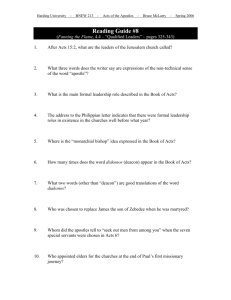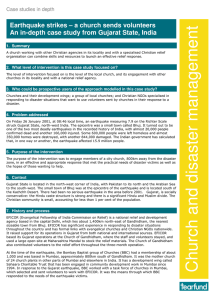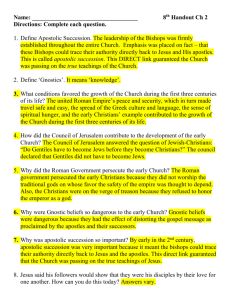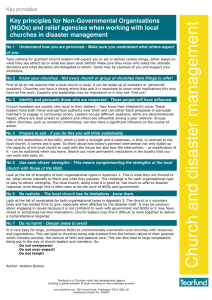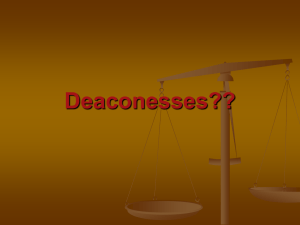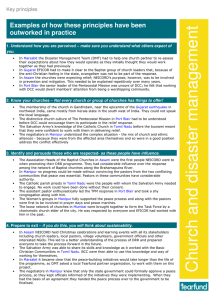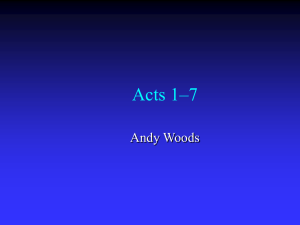The Catholic Apostolic Church and its Gordon Square Cathedral: Bloomsbury,
advertisement
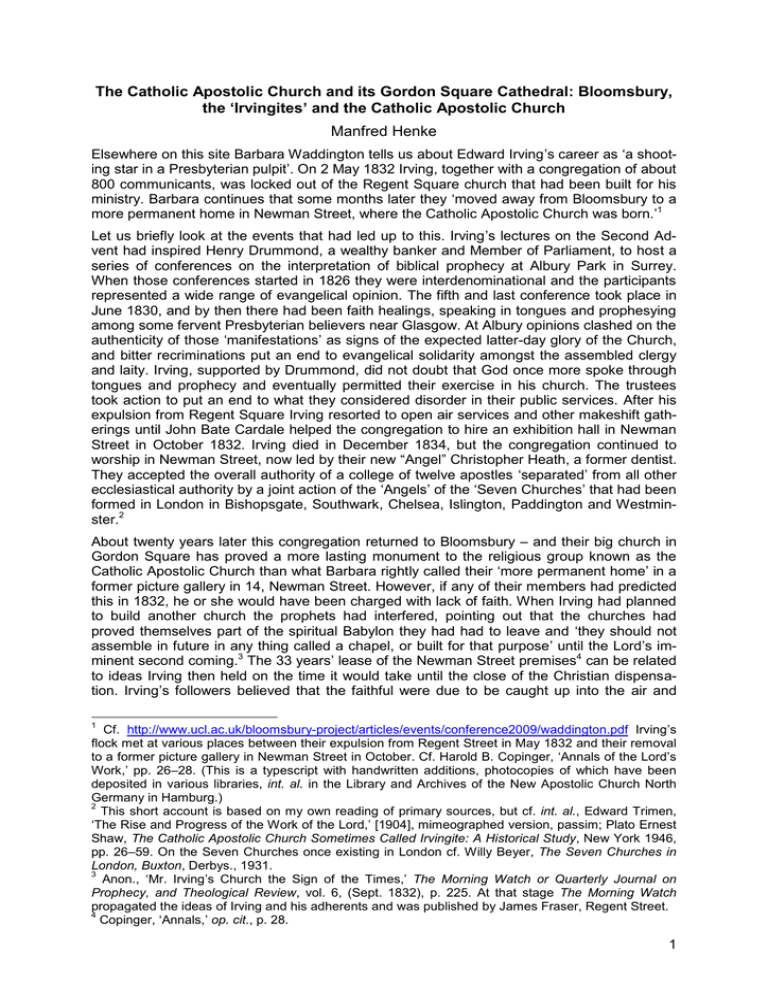
The Catholic Apostolic Church and its Gordon Square Cathedral: Bloomsbury, the ‘Irvingites’ and the Catholic Apostolic Church Manfred Henke Elsewhere on this site Barbara Waddington tells us about Edward Irving’s career as ‘a shooting star in a Presbyterian pulpit’. On 2 May 1832 Irving, together with a congregation of about 800 communicants, was locked out of the Regent Square church that had been built for his ministry. Barbara continues that some months later they ‘moved away from Bloomsbury to a more permanent home in Newman Street, where the Catholic Apostolic Church was born.’1 Let us briefly look at the events that had led up to this. Irving’s lectures on the Second Advent had inspired Henry Drummond, a wealthy banker and Member of Parliament, to host a series of conferences on the interpretation of biblical prophecy at Albury Park in Surrey. When those conferences started in 1826 they were interdenominational and the participants represented a wide range of evangelical opinion. The fifth and last conference took place in June 1830, and by then there had been faith healings, speaking in tongues and prophesying among some fervent Presbyterian believers near Glasgow. At Albury opinions clashed on the authenticity of those ‘manifestations’ as signs of the expected latter-day glory of the Church, and bitter recriminations put an end to evangelical solidarity amongst the assembled clergy and laity. Irving, supported by Drummond, did not doubt that God once more spoke through tongues and prophecy and eventually permitted their exercise in his church. The trustees took action to put an end to what they considered disorder in their public services. After his expulsion from Regent Square Irving resorted to open air services and other makeshift gatherings until John Bate Cardale helped the congregation to hire an exhibition hall in Newman Street in October 1832. Irving died in December 1834, but the congregation continued to worship in Newman Street, now led by their new “Angel” Christopher Heath, a former dentist. They accepted the overall authority of a college of twelve apostles ‘separated’ from all other ecclesiastical authority by a joint action of the ‘Angels’ of the ‘Seven Churches’ that had been formed in London in Bishopsgate, Southwark, Chelsea, Islington, Paddington and Westminster.2 About twenty years later this congregation returned to Bloomsbury – and their big church in Gordon Square has proved a more lasting monument to the religious group known as the Catholic Apostolic Church than what Barbara rightly called their ‘more permanent home’ in a former picture gallery in 14, Newman Street. However, if any of their members had predicted this in 1832, he or she would have been charged with lack of faith. When Irving had planned to build another church the prophets had interfered, pointing out that the churches had proved themselves part of the spiritual Babylon they had had to leave and ‘they should not assemble in future in any thing called a chapel, or built for that purpose’ until the Lord’s imminent second coming.3 The 33 years’ lease of the Newman Street premises4 can be related to ideas Irving then held on the time it would take until the close of the Christian dispensation. Irving’s followers believed that the faithful were due to be caught up into the air and 1 Cf. http://www.ucl.ac.uk/bloomsbury-project/articles/events/conference2009/waddington.pdf Irving’s flock met at various places between their expulsion from Regent Street in May 1832 and their removal to a former picture gallery in Newman Street in October. Cf. Harold B. Copinger, ‘Annals of the Lord’s Work,’ pp. 26–28. (This is a typescript with handwritten additions, photocopies of which have been deposited in various libraries, int. al. in the Library and Archives of the New Apostolic Church North Germany in Hamburg.) 2 This short account is based on my own reading of primary sources, but cf. int. al., Edward Trimen, ‘The Rise and Progress of the Work of the Lord,’ [1904], mimeographed version, passim; Plato Ernest Shaw, The Catholic Apostolic Church Sometimes Called Irvingite: A Historical Study, New York 1946, pp. 26–59. On the Seven Churches once existing in London cf. Willy Beyer, The Seven Churches in London, Buxton, Derbys., 1931. 3 Anon., ‘Mr. Irving’s Church the Sign of the Times,’ The Morning Watch or Quarterly Journal on Prophecy, and Theological Review, vol. 6, (Sept. 1832), p. 225. At that stage The Morning Watch propagated the ideas of Irving and his adherents and was published by James Fraser, Regent Street. 4 Copinger, ‘Annals,’ op. cit., p. 28. 1 meet the Lord after three and a half years of intense evangelistic activity. Alternatively, Irving seems to have thought in terms of thirty years’ preaching. For this, new apostles were expected and prayed for. The first of these apostles was John Bate Cardale, then a solicitor in Bedford Row, Bloomsbury.5 Cardale’s views of the apostleship, the church, its liturgy and various other aspects of doctrine shaped the new movement to a large extent – and they differed from Irving’s. Looking back on the beginnings after ‘three-and-thirty years’ he wrote in 1865: ‘There was great zeal and much love, but little knowledge and prudence; and therefore many mistakes.’6 For some years the new movement had been threatened with extinction. The apostles, who on 14 July 1835 had been ‘separated’ from all former ecclesiastical duties to fulfil their work for Christendom, had experienced quite a different kind of ‘separation’ of the apostles in 1840–1841. They had parted company, fearing that their work had failed, until Cardale in 1847 inspired ten of the twelve with a sense of purpose again. They agreed to start the work of ‘sealing’ by laying their hands on the members of the flock to convey to them the Holy Spirit.7 Whereas in the heady early days the faithful had expected that the spirit, once poured out on them, would enable them to lead sinless lives and perform miracles as testimonials to the truth of their message, Cardale now expressly warned them to expect no such thing.8 Unlike some of his colleagues he did not actively pursue the idea of filling up the number of apostles in order to enable them to be sent out in the full power of their ministry to perform what they had originally expected to do: unite all devout Christians in preparation for the Lord’s second coming.9 There were other changes, too. Originally, the services of the ‘Irvingites’, as they used to be called, had been conducted according to the simple forms of the Church of Scotland. Cardale had joined Irving’s Presbyterian congregation because the Rev. Baptist Noel, Anglican minister of St. John’s Chapel in Bedford Row where Cardale used to worship before, had preached against the prophetic messages Cardale’s wife and daughter had uttered.10 In 1832 Cardale became the first apostle of the movement and after some time he took pains to reshape it along High Church lines. Starting in 1838 communion tables were replaced by stone altars, pulpits were put into the church buildings, the ministers were made to wear vestments and in 1847 a liturgy based on the Book of Common Prayer, the Roman missal and various ancient Christian liturgies was introduced.11 In Albury, an Apostles’ Chapel built in the then fashionable neo-Gothic style was opened up in 1840, and the simple building in Newman Street was gradually becoming 5 Cf. Manfred Henke, ‘175 Years Ago: The Call of John Bate Cardale and the Contemporary Idea of Apostleship,’ http://www.nak.org/fileadmin/download/pdf/Call_of_Cardale-2010.pdf (URL), pp. 9–19. 6 [John Bate Cardale,] The Character of our Present Testimony and Work, London 1865, p. 2. 7 Cf. [Manfred Henke], ‘Apostles’ Council 1851: No Agreement on Measures to Restore the Twelvefold Unity of Apostles,’ www.nak.org/en/news/publications/article/15103/ (URL), pp. 1–4. In a letter to Henry Drummond, dated 17 February, 1847, Cardale writes that the ‘Apostles at their separation’ had declared their inability to take collective action on certain matters. Cf. Drummond Papers, The Duke of Northumberland’s Archives, Alnwick Castle, Northumberland, C/11/7 (henceforth cited as ‘Drummond Papers’, microfilms at the Bodleian Library, Oxford). 8 Cf. Henke, ‘175 Years Ago: The Call of John Bate Cardale and the Contemporary Idea of Apostleship,’ op cit., pp. 18-9. 9 Cf. [Henke], ‘Apostles’ Council 1851: No Agreement on Measures to Restore the Twelvefold Unity of Apostles,’ op. cit., pp. 4-6. 10 John Lancaster, ‘John Bate Cardale, Pillar of Apostles: A Quest for Catholicity,’ B. Phil. thesis St. Andrews, 1977, pp. 51-3, 94. 11 Cf. Copinger, ‘Annals,’ op. cit., pp. 72–73, 77–78, 80–81, 89; ‘Drummond Papers’ C/11/7; [R.M. Heath ?], ‘Teaching on the History and Meaning of the Monthly Assembly of the Seven Churches in th London (given. at Southwark on 4 October, 1936)’, undated mimeographed edition by Norman Priddle, p. 3. John Bate Cardale, letter to Thomas Dowglasse, dated Tavistock Square, May 1852, p. [3]; MS Cardale’s notes on the MS of Dowglasse, A Chronicle of Certain Events, London 1852, notes on p. 43 of Dowglasse’. The two last mentioned MSS are owned by Mr Mark Cardale, London. A MS seating plan of the Council is owned by Lynn and William Cardale of Bradfield St George, Bury St Edmunds. I wish to record my gratitude for the generous access to family papers connected with the kindest hospitality that has been extended to me by members of the Cardale family. 2 anachronistic, a ‘house poor, unsightly, unconsecrated,’ though still venerated as the central church of the highly symbolical Seven Churches of London.12 The new church building was to be adapted to what was required ‘now that through the mercy of God, His worship has in all essentials been revealed to us’.13 The beginnings of the new religious movement were closely related to Edward Irving’s ministry, but its members had always objected to being called ‘Irvingites’, though for practical purposes they sometimes referred to themselves under that name.14 Towards the end of 1847 it had been decided by the ten remaining apostles collectively that the proper name of the congregation assembled in Newman Street was ‘the One, Holy, Catholic and Apostolic Church, London, The Central Church’.15 The designation quotes the Nicene Creed (or rather the Niceno-Constantinopolitan Creed of AD 381) and was part of a conscious endeavour not to be sectarian, but it also implied that all other Christian denominations were sectarian because they did not join in with the apostles and the special work done by God through their ministry.16 In 1849 John Bate Cardale decided to have the name ‘Catholic Apostolic Church’ affixed to the church buildings in England and to have it used for public reference. This decision seems to have been confirmed for the 1851 census.17 Erecting ‘the Noblest of Metropolitan Churches’ In the seventh chapter of the Apocalypse (the last book of the Christian Bible) the number of those who are sealed against the destructive forces of the last days is given as 144,000, divided into twelve tribes. Each one of the twelve apostles that had eventually been ‘separated’ in 1835 had been assigned one of those ‘tribes’ among the Christian nations. Cardale, the first called of them, had been put in charge of the tribe of Judah, meaning England. Originally, the Seven Churches of London had been meant to be jointly administered by the college of apostles, being a ‘pattern’ of the universal Christian church that they felt sure would be gathered under apostles in preparation for the Second Advent.18 When the unity of the college of apostles was lost and hope for a universal church ruled by apostles had waned, it was agreed in 1846 that Cardale should be in charge of the Seven Churches for the time being. This arrangement was renewed in 1851 and thus became permanent although in theory the way was left open for a return to the original arrangement on the anticipated begin- 12 [Knight], On Building a Church for Divine Worship. A Discourse Delivered by One of the Deacons of the Central Church, 3d Nov. 1850, London, n.d., p. 7. 13 Ibid., p. 4. 14 Cf. Charles J.T. Boehm, Was sind die sogenannten Irvingianer für Leute? Eine Frage beantwortet für Alle, die über diese Sache etwas Zuverlässiges zu wissen wünschen, Berlin 1851. British Library (BL) 4136.df.22, translated as Who are the Irvingites?, London 1851, BL 764.i.15.(2) 15 nd Statement by John Bate Cardale, ‘Conference with the Angels, March 2 , 1853,’ p. 1 as part of a lithographed series entitled ‘Minutes of Conferences’. A nearly complete run of these minutes is in the Library and archives of the New Apostolic Church North Germany, Hamburg. Scholars can send inquiries and apply for digital copies via info@nac-history.com. 16 Cf. [John Bate Cardale], A Manual or Summary of the Special Objects of Faith and Hope in the Present Times, London 1843, pp. vii, 56, 98, 122. The text with explanations is available on www.nak.org/fileadmin/download/pdf/CardaleManual.pdf. Cardale repeated those sentiments and expanded on them in [John Bate Cardale], A Discourse Delivered in the Catholic Apostolic Church, Gordon Square, on the Occasion of the Consecrating the Altar, and Opening the Church for Public Worship, Christmas Eve, 1853, London 1854, pp. 6–15. 17 Copinger, ‘Annals’, op. cit., pp. 87, 92. 18 Cf. the so-called ‘Testimonies’ to King William IV., p. 33, to the Archbishop of Canterbury and the Anglican clergy, p. 74 of the octavo edition or p. 62 of the quarto edition, the ‘Great Testimony’ directed to the spiritual and temporal ‘rulers’ of the Christian nations, § 111 of the octavo edition or p. 80 of the quarto edition. These testimonies are discussed and the texts edited in a series of online publications that I wrote and edited in 2006: www.nak.org/en/news/publications/article/14355/ www.nak.org/en/news/publications/article/14439/ www.nak.org/en/news/publications/article/14501/ www.nak.org/en/news/publications/article/14578/. 3 ning of the full apostolic work of reconstituting the Christian church as a united body ready for Christ’s Second Coming.19 Suggestions for having a new church built were first vented by Christopher Heath, the ‘Angel’ or head of the church, in 1844 – more or less simultaneously with the introduction of vestments for his clergy.20 In 1847 the deacons at the central church were at work adapting the old Newman Street premises to the new liturgical practices. In 1849 they took some steps towards having a new church built, and from January 1850 various sites were explored.21 In May 1851 they recorded that the Angel and the Apostle had endorsed the Gordon Square site. Not all of them were happy with that decision because they would have preferred a freehold property and the Duke of Bedford was not prepared to enfranchise the chosen property. They turned towards negotiating a long lease and the right of renewal. The deeds were finally signed in October 1850.22 The Duke of Bedford reserved the right to approve of the plans for the projected church, and consequently, a decision on its design was a matter of some urgency. After discussing various options the deacons decided to commission Brandon and Ritchie.23 Together with his already deceased brother Joshua Arthur, John Raphael Brandon had made his name as an author of books on medieval English architecture rather than as a practising architect. The books contained professional information on the practical details of building Gothic churches – and the deacons obviously wanted him to apply his knowledge and provide their congregation with a ‘glorious structure’ for worship in what they hoped would be ‘the noblest of Metropolitan Churches’.24 There were objections to this grand project. One was practical. A Mr Stevenson protested, trying ‘to show that the adoption of Mr Bandon’s Design was fraught with difficulties & extravagance’, and telling his fellow deacons that he ‘would greatly prefer having a finished Church according to the means we possess’ rather than an unfinished one. But even while doing so it was clear to him that his fellow deacons had already decided in favour of the ambitious project.25 The other objection could be classed as theological. Obviously, there were still members of the congregation who remembered the prophetic injunctions against too permanent a structure. To critics of what was apparently called ‘the new order of things’, the very fact of investing so much money and effort into ‘a splendid monumental place of assembly’ seemed to 19 Copinger, ‘Annals’, op. cit., p. 93; ‘Drummond Papers’ C/11/25 of 27 Feb. 1851; Cardale, ‘At the th Conference with the Angels Wednesday 20 Aug. 1851,’ pp. 8–10. For a transcription of this document cf. www.nak.org/fileadmin/download/pdf/Notes20.08.1851.pdf. Lately, further light has been shed on this by John Bate Cardale’s comments on Thomas Dowglasse’s MS (as mentioned in note 11), comments regarding pp. 42, 55, 76–81 of the MS. For the leading ministers of the church and other information I am indebted to Seraphim Newman-Norton, ‘The Twelve Tribes of Christendom, Vol. One: Congregations in the Tribe of Judah. An Historical Directory of Catholic Apostolic Churches in England & Wales,’ unpublished draft book, entry: ‘London, Central Church’. I wish to record my thanks to the author for making this accessible to me and giving permission to quote from it. 20 MS Deacons’ statement to the flock of 6 July 1853 (separate booklet), p. 1. The introduction of vestments in the central church can be dated to either 1843 or 1844 by reference to remarks concerning the need to replace the old ones because of wear, cf. MS Deacons’ minute Book 1847-1852, p.87, MS Minute Book of the Finance Committee, p. 20. These and other MSS relating to deacons and deaconesses at Gordon Square are kept at the Library and archives of the New Apostolic Church North Germany, Hamburg. For access cf. above, note 15. 21 MS Deacons’ Minute Book 1847–1852, pp. 3–4, 7, 9, 25–26, 31, 33, 51–52. 22 Ibid., pp. 33–36, 40–43, 45, 63–64. 23 Ibid., pp. 45–51, 53–62. 24 Cf. the information on Brandon in Dictionary of National Biography (DNB), vol. 6, pp. 22–23; Oxford Dictionary of National Biography (ODNB), vol. 7, p. 362; quotations are taken from MS Deacons’ Minute Book 1847–1852, p. 57. 25 MS Deacons’ Minute Book 1847–1852, p. 58. 4 advertise an attitude described as ‘The Lord delayeth his coming – The time is not yet!’26 To counter such sentiments the head deacon, Mr Knight, ‘was requested to draw the attention of the Flock in an appropriate Sermon to the high duty & privilege of building a Central Church for the Worship of God’. Having it printed ‘was sanctioned by the Apostle with some few alterations & additions’.27 Thus, the printed version gives us a quasi-official statement of how the community at that time envisaged the Second Advent. There were to be two different groups of Christians who would be translated to heavenly glory at different times, the ‘firstfruits’ sealed by the apostles preceding the great harvest of faithful Christians. The latter might use the building to worship there.28 Once the ground was cleared on theological lines, the practical difficulties proved harder to overcome. Mr Stevenson’s warning to his fellow deacons that they might end up with an unfinished church if they adopted too ambitious a scale proved all too prescient. In November 1850 the cost of the complete building was calculated at £30,000, and it was believed that £14,200 would suffice to finish ‘the main body of the building ..., comprising all the parts necessary for the daily, monthly, and other solemn services’ and ‘suitably fitted with ecclesiastical furniture and sittings’. They had £11,000 in hand and hoped to raise another £3,200 soon.29 In June 1851, after about £1,800 had been spent on the foundations, the estimated cost for completing the body of the church had already risen to £21,000. Mr Knight expressed ‘considerable anxiety’ but agreed with Mr King’s sentiment that ‘we cannot go back, we must hope to complete the undertaking.’30 In this contract various necessary items like the floor of the church, ‘beaming & Ventilation’ and about one hundred doors had not been included.31 A number of suggestions on how to economize were made, but the plans could not simply be changed once the Duke of Bedford had approved them, and where changes seemed possible the savings had to be weighed up against future inconveniences. Again and again there were appeals to the flock to give or lend more money, and they were quite successful. In addition, several members lent or bequeathed money towards the completion of the church.32 When the new building was finally opened for worship on Christmas Eve 1853 it was manifestly incomplete. Two bays of the church as originally planned were still missing. The west wall was made of brick instead of the Bath stone used elsewhere because it was meant to be pulled down once the building was completed. It has remained to the present day. There are four substantial columns meant to take the weight of a central spire about 300 feet high. The provisional covering, erected at a cost of £160, still remains and there is no spire. In July 1853 the estimated cost had risen to £27,410, of which about a quarter (£6,360) had to be financed by various loans.33 The deacons had to find another £6,000 for the annexe of flats known as ‘the Cloisters’ and the eastern gatehouse connecting it to the actual church.34 At the opening Cardale consecrated the altar, not the actual church building. In his sermon he pointed out that this act expressed the congregation’s desire ‘so far as your ability extends, to consecrate the whole’ – which was impossible ‘from circumstances attending the tenure of your property, and other considerations of a temporary nature’.35 He thus alluded to the site not being freehold and even encumbered with debts. So it was not ‘effectually secured to the perpetual use of the Catholic Church for the worship of Almighty God during this 26 Joseph Amesbury, Memorial to the Ministers and other Brethren of the Churches in Zion, London 1853, pp. 12, 17, 25. 27 Ibid., p. 64, 67. 28 [Knight], On Building a Church for Divine Worship, op. cit., pp. 18–19. 29 Ibid., pp. 5-6. 30 MS Minute Book of the Finance Committee, p. 5. 31 Ibid., p. 8; MS booklet with deacons’ statement to the flock of 6 July 1853, p. [10]. 32 Cf. MS Minute Book of the Finance Committee, pp. 8, 20, MS Deacons’ Minute Book 1856–1877 (no pagination), minutes of 14 June 1872. For a legacy cf. loose papers, minutes of 18 May 1853. 33 MS booklet with deacons’ statement to the flock of 6 July 1853, no pagination. 34 MS Deacons’ Minute Book 1856–1877, minutes of 14 June 1872. 35 [Cardale], A Discourse Delivered in the Catholic Apostolic Church, Gordon Square, on the Occasion of the Consecrating the Altar, op. cit., p. 3. 5 age’ – a condition regulating the dedication of church buildings which Cardale himself had imposed.36 Starting in 1872, money collected in a ‘church completion fund’ was used to replace a provisional pulpit and other fittings that were deemed inadequate, as well as to beautify the sanctuary and the West entrance and install amenities such as toilets near the West entrance. These works were still supervised by Brandon.37 In 1885 John Belcher, a member of the congregation, drew up plans for a completion of the building on the original even grander scale.38 Although some further work was added even in the twentieth century, 39 the building has remained unfinished – and (as far as we know) unconsecrated. A Centre of Worship for London and England The Catholic Apostolic Church developed a hierarchy headed by the Apostles in all matters related to the ‘universal church’ and by ‘Angels’, ministers of episcopal rank, who ‘ruled’ the ‘particular churches’.40 The building in Gordon Square mirrors the distinction between the ‘universal church’ and the ‘particular church’. The Angel’s throne was placed in the choir or sanctuary of the main body of the church. The Apostle had a separate chapel reserved for services of intercession for all the churches in his ‘tribe of Judah’, meaning England. For this ‘English Chapel’ the Apostle contributed towards the structure from offerings given by those who were to receive the ‘sealing’ and he had in hand £700 donated for the decoration of the chapel.41 In addition, individual churches sent in various sums of money.42 The nave of the church had to be planned on a scale sufficient to host what was known as the Meeting of the Seven Churches. Every fourth Tuesday the ministers and flocks of the Seven Churches were invited to take part in a eucharistic service in which the epistles to the seven churches from the second and third chapter of the Apocalypse were read, interspersed with prayers, psalms and anthems.43 These gatherings had developed from makeshift beginnings. What had been the presbytery of Irving’s church had been joined by representatives of three other churches (Bishopsgate, Southwark, and Chelsea) that accepted the four Apostles acknowledged by them towards the end of 1833. Since 28 December 1833 these council meetings were led by the Apostles with Apostle Cardale presiding.44 A prophecy of 26 April 1834 had called for seven churches to be established in London and produced a spate of evangelistic activity that had resulted in three further churches (Islington, Paddington, and Westminster) being gathered.45 On every fourth Tuesday ministers from all seven churches were to gather as the ‘Council of Zion’ and soon the members of the Seven Churches were enjoined to attend the morning and evening services at the Central Church with which the council meetings were opened and closed. In its structure the council was to be an antitype of the Old Testament Tabernacle and ideally it 36 [Catholic Apostolic Church], General Rubrics; or, Rules for the Celebration of the Divine Offices, etc. England, London 1852, p. 111. 37 Cf. various entries in MS Deacons’ Minute Book 1856–1877 starting in 1872. 38 There is an entry on Belcher in ODNB, vol. 4, pp. 878-9, cf. also Seraphim Newman-Norton, ‘Biographical Index of Those Associated with the Lord’s Work,’ London 1971, p.9. 39 A stained glass window depicting Christ’s Second Coming was added in the South transept at Pentecost 1908; cf. Seraphim Newman-Norton, ‘The Twelve Tribes of Christendom,’ op. cit. 40 Cf. [Cardale], A Discourse Delivered in the Catholic Apostolic Church, Gordon Square, on the Occasion of the Consecrating the Altar, op. cit., pp. 10-11. 41 MS Deacons’ minute Book 1847–1852, pp. 84, 85, 87–88, MS Minute Book of the Finance Committee, p. 11. 42 MS Minute Book of the Finance Committee, p. 11. 43 Copinger, ‘Annals,’ op. cit., p. 82. Cf. The Liturgy and Other Divine Offices of The Church, London [1847], ‘Forms for Occasional Use in the Celebration of the Holy Eucharist: On the Meeting of the Seven Churches in London.’ 44 Edward Trimen, ‘The Rise and Progress of the Work of the Lord,’ [1904], mimeographed version, p. 40. 45 Ibid., p. 44, Copinger, ‘Annals,’ op. cit., pp. 41–44, 47. 6 was to have 135 members.46 In the crisis of 1840 the meetings had been interrupted and the Council of Zion suppressed,47 but in 1847 the Meetings of the Seven Churches were started again. Instead of the ‘Council of Zion’ the Apostle held ‘conferences’ with the Angels of his ‘tribe’ with liberty for other ministers to attend. There the Apostle conveyed information to the ministers and announced his answers to questions brought up by them. Most of the minutes of these gatherings are now available for historical research.48 Deacons, Deaconesses and the Poor – Charity, Gender and Social Class There were three ‘orders’ of the ministry: Bishops, priests and deacons. Looking after the poor of the congregation was a task entrusted to the deacons and deaconesses. They brought faith and dedication to their task, but they were people of their age as well. The minutes in which they recorded their activities give us occasional glimpses of gender relations and of their view of the social problems of their age. Ideally, the deacons were seven in number and men of substance who could be trusted to look after the temporal affairs of the church and form a judgement on matters of poor relief. Every Sunday, when the Eucharist was celebrated, they received communion after the priests and before the flock. There were ‘underdeacons’ and various minor office-bearers who were not ordained by the Apostle, but blessed by the Angel, and they received communion together with the other members of the flock. The deaconesses were unordained and consequently classed with the underdeacons. In the evangelical awakening women had been given a large scope for pastoral work among the poor.49 Originally, the Catholic Apostolic movement had been part of that awakening, but its leaders had soon criticized the evangelicals severely and reshaped the Church along High Church lines. Their critical view of religious societies was founded on their view that those societies tried to do what only Christ and his Church could achieve. Whereas the Catholic Apostolics waited for Christ to come in glory to establish the millennium, they held that evangelicals expected an Age of Reform to usher in a perfect state of society previous to Christ’s return, which was thus held to be afar off.50 According to Catholic Apostolic teaching all religious and social activities were to be directed by the church, and welfare was seen to be the proper sphere of deacons and deaconesses. In the beginnings prophesying women exercised a huge influence. One of them had been Emma Cardale, the Apostle’s wife. The Apostle’s sisters, Emily and Mary Elizabeth had prophesied alongside their sister-in-law, and the latter was now a deaconess at Gordon Square. Gradually, the influence of the prophetesses had been replaced in the course of the changes involved in the development from a charismatic movement to a hierarchically ordered church.51 But in spite of these changes, the deaconesses, some of them unmarried women of considerable means, were not slow to stand up for their convictions. In January 1857 Miss Gason, the Chief Deaconess, criticized the deacons for incurring new expenses ‘while the debt on the church was still unpaid.’ Some of the deacons complained of this ‘extraordinary statement’ and even wondered if there was ‘a universal Necessity of Deaconesses.’ The deaconesses were not likely to be impressed by this because they could get instructions directly 46 Ibid., p. 48–50, 73, 82. Cf. Heath ?], ‘Teaching on the History and Meaning of the Monthly Assembly of the Seven Churches in London,’ op. cit., passim. 47 Cf. [Manfred Henke], ‘Apostles’ Council 1851: No Agreement on Measures to Restore the Twelvefold Unity of Apostles,’ op. cit., p. 1. 48 Cf. supra, note 15. 49 Richard Price, British Society 1680-1880: Dynamism, Containment and Change, Cambridge 1999, p. 216. 50 Cf. e.g. The Morning Watch, vol. 6 (1832–1833), pp. 226, 246, 260, 267–268, 282; ibid., vol. 7 (1833–1834), pp. 74–75, 82–83, 248. 51 There are some observations on this process in Tim Grass, ‘“The Taming of the Prophets”: Bringing prophecy under control in the Catholic Apostolic Church,’ Journal of the European Pentecostal Theological Association, vol. 16 (1996), pp. 58–70. The question of gender relations awaits further study. 7 from the Angel or one of the priests, and we find them successfully appealing to the Angel against a decision made by the deacons.52 The Apostle called upon the faithful to dedicate their lives to the service of God and to ‘let high and low, rich and poor, be one in the Lord’ and ‘none despise the other.’53 In practice, this was not always easy to achieve, but counter-measures were taken when instances of social discrimination were brought to the deacons’ attention. One of them once pointed out ‘the partiality perhaps merely inconsiderate, shewn by the Under-deacons in filling up the nave-seats, so that practically rich people were put in the front seats, & poor people kept back.’ It was ruled that ‘the front seat of all was reserved for the infirm, but the rest ought to be filled in the order in which people arrived in church.’54 A keen sense of a Christian’s duty towards the poor had moved the deacons in 1849 to establish a home for about eight widows in one of the houses belonging to the Newman Street property they had rented.55 So those fortunate few had a chance to avoid the dreaded workhouses of the ‘Poor Law Unions’ created by the Poor Law Amendment Act of 1834. We find on record that at least one poor widow had been taken into Miss Gason’s house in Marylebone before her death and that deacons and deaconesses had given of their private means in addition to what was at their disposal from the offerings for the poor.56 Once the congregation had moved to Gordon Square, the widows were given pensions that enabled them to live in rented accommodation. Those payments were continued even in times of financial difficulties after Miss Gason had reminded the deacons ‘of the refusal of parochial authorities to render assistance to the destitute because of their connection with this Church.’57 In an age before elementary education was compulsory, the Established Church and the various dissenting churches set up rival schools for the poor, many of them in the shape of Sunday Schools that taught basic skills in reading and writing along with religious instruction.58 In 1873 the Apostle Cardale warned that parents should not suffer their children ‘to go to Sunday Schools, or to go to other places of worship, when within possible reach of your own church,’ adding: ‘Let no fancied advantages of education or worldly advancement induce you to violate this injunction.’ He called it ‘a sin, from which has resulted the loss of hundreds of our children, who, as they have grown up, have forsaken the faith of their parents.’59 The deacons and deaconesses at the Gordon Square church had been aware of that problem many years before. Already in September 1850 the same Mr Stevenson who warned against too grandiose a building project kept pressing for a consideration of the question of how to educate the children of the poorer members of the flock while his colleagues were preoccupied with the building project. When they eventually turned their attention to the question in December 1851 Mr Stevenson ‘thought that the children ought to have the advantage of schools’ and Mr Ritchie agreed on the desirability of such a project, so ‘that the little ones may not be left to go to other streams – having been led to understand that the subject was much upon the heart of the apostle, he would wait for instruction and direction from that quarter.’60 The problem remained unsolved for some time. In a deacons’ meeting of 4 May 1853 we read: ‘The case of Children of the Flock who avail themselves of parochial & other 52 MS Deacons’ Minute Book 1856-1877, 21 January 1857, cf. 7 Jan. 1857; MS Minutes of the Deaconesses’ Meetings at the Central Church, London, 1853–1873, pp. 2–3, 8–9. For the deaconesses’ not all that well-defined position in the hierarchy cf. Miller, History and Doctrines of Irvingism, op. cit., vol. 2, p. 55. 53 [John Bate Cardale], An Address to the Churches in London. Delivered at the Close of the Visitath tion, Tuesday, 4 March, 1873, London [1873], pp. 14–15. 54 Loose papers, minutes of 21 Jan. 1857. 55 MS Deacons’ Minute Book 1847–1852, p. 15. 56 Loose papers, note by J. King, 21 Dec. 1852, MS Deacons’ Minute Book 1847–1852, pp. 89–90. 57 Loose papers, minutes 27 Jan. 1853, sketch minutes of 12 Oct. [1853], minutes of 16 Nov. 1853. 58 Cf. Llewellyn Woodward, The Age of Reform, 1815–1870 (The Oxford History of England), Oxford 1961, pp. 474–84; Michael R. Watts, The Dissenters, vol. 2, Oxford 1995, pp. 284–303; K.D.M. Snell, Paul S. Ell, Rival Jerusalems: The Geography of Victorian Religion, Cambridge 2000, pp. 274–89. 59 [Cardale], An Address to the Churches in London, op. cit., p. 10. 60 MS Deacons’ Minute Book 1847–1852, pp. 52, 54, 96f. 8 Schools for Education & being therefore compelled to attend the district churches brought forward – the necessity of some remedy being provided obvious.’61 The deaconesses considered the matter in June 1853. They resolved to make an addition to their quarterly report to the Angel ‘relative to the importance of some measures being taken for the secular instruction of the children of the poor in the Flock, in order to shield them from a temptation frequently presented to their Parents from the absence of this advantage, to seek it in Schools where they are liable to be alienated from the defences of the Apostolic Church.’62 The deaconesses took steps to teach the girls themselves and through some young women who offered their help. They drew up a list of 23 girls aged 6-14, but quite obviously, at the start the parents were not keen to send their girls and took them out of school when they considered them old enough to contribute to the family finances. The school was finally opened on 15 October 1855, all the teaching staff being voluntary. In addition to teaching them in class, women also instructed some girls in household duties and found them situations as domestic helps, feeling that they had acquired ‘habits of industry & attention’.63 From 1871 there was discussion about a school for boys and the appointment of a schoolmaster. The Apostle gave money from a special fund at his disposal to pay a salary of £100 to a schoolmaster employed at Gordon Square. The deacons managed to augment this to £125 a year, feeling sure that otherwise they would not get a sufficiently qualified teacher.64 Apparently the boys were expected to sing in the choir in return – and they were not always easily tractable on those occasions.65 Again, some parents refused to send their offspring to the school maintained by their church, one of them telling a deacon in December 1873 ‘that the School had a bad name & that the boys got into bad habits’. He also complained that ‘the boys are taught some things which are no use to them in after life & as if they were gentlemen’s sons, & are not taught that which would be more useful to them in the commercial life which most of them will follow.’66 In refusing to have their children taught what might be fit for ‘gentlemen’s sons’ but would not immediately profit them in their walk of life such members of the flock were following the Apostle’s injunction that their common faith should not touch their present status in society.67 A ‘Time of Silence’ All ministers of the Catholic Apostolic Church had to be ordained by Apostles. The last of the original twelve, Francis Valentine Woodhouse, departed this life on 3 February 1901. The church entered into a ‘time of silence’. No ministers could be ordained, and James Malcolm Lickfold, a deacon who was the last ordained minister of the Central Church, helped to turn the building over to the Anglican Chaplaincy to the University of London, an arrangement completed after his death, though it seems that not all the remaining members were happy with this decision. Between 1963 and 1992 the building was known as the University Church of Christ the King. This move was vigorously opposed by the last surviving Catholic Apostolic priest, Dr Wilfrid Maynard Davson of Paddington who taught his flock not to cease assembling in their own church building – a practice still observed among Catholic Apostolic stalwarts in Germany. Since 1992 the English Chapel has been leased to the ‘Forward in Faith’ movement, a traditionalist group within the Church of England.68 61 Loose papers. MS Minutes of the Deaconesses’ Meetings at the Central Church, London, 1853–1873, p. 23. 63 Ibid., pp. 48, 58, 61, 62, 65, 66, 68–69, 70–74, 78, 80, 83–84, 87–89, 117. 64 MS Deacons’ Minute Book 1856–1877, 27 Oct. 1871. 65 Ibid., 26 Sept. 1873, 3 Oct. 1873, 23 Jan. 1874. 66 Ibid., 19 Dec. 1873. 67 [Cardale], An Address to the Churches in London, op. cit., p. 11. 68 5 Seraphim Newman-Norton, The Time of Silence, London 2005, pp. 90-6. The information contained in a brochure once distributed by the Anglican Chaplaincy to the Universities and Polytechnics of London, The University Church of Christ the King, London, n.d., p. [8] is incorrect. Cf. also the information on http://www.fifparish.com/home/christtheking/index.htm and http://www.christthekingulac.org.uk/. 62 9 When the churches in Britain were given up, church furniture, vestments and records were dispersed, destroyed or locked up. In this situation Mr Norman Priddle, who served as Catholic Apostolic bookseller and publisher, took an unusual step. Until his death in August 1977 he sold books and manuscripts as they arrived at his flat at the Cloisters to Karl Weinmann in Hamburg. Mr Priddle expressed ‘a genuine spiritual affinity’ with Karl Weinmann, who had evinced great interest in the history of the Catholic Apostolic Church, and he quite obviously took care to send him some of his rarer documents – including the manuscripts quoted in this article.69 This is all the more remarkable as Mr Priddle knew that his correspondent was an Apostle of the New Apostolic Church which most of his co-religionists considered an illegitimate offspring of the Catholic Apostolic Church. The beginnings of the New Apostolic Church can be traced back to a series of events in late 1862 and early 1863 when some Catholic Apostolic ministers and their flock in Hamburg had declared in favour of further Apostles being called. Until the 1960s most members lived in Germany, but due to world-wide mission efforts its more than 10 million members, served by just over 250,000 ordained ministers, can now be found in more than 200 countries (including Britain).70 69 Cf. a letter of Norman Priddle to Karl Weinmann, dated 13 January, 1978, Library and archives of the New Apostolic Church North Germany, Hamburg, file “Priddle 1. Jan. 1972”. 70 Cf. the official website of the New Apostolic Church International at http://www.nak.org/en/about-thenac/. 10
